| |
Strawberry Fields for Winter
Last weekend, I had to make dessert for a dinner party. Wanting to do something with fruit, I headed to the produce section, thinking about citrus or maybe pears. Those thoughts were blown out of my head by the sight of row upon row of . . . bright red strawberries. And a big sign proclaiming the arrival of the "Strawberry Fair." In Japan, winter is the high season of the strawberry. Strawberries sit in little boxes in displays at the front of the store, announcing their provenance and price ("Fresh Strawberries from Sendai! 680 yen!"), drawing attention away from all the other fruits. Every patisserie sets out an array of strawberried treats ― filled, topped, stuffed with jam, you name it. Strawberry KitKats, strawberry danish, and strawberry eclairs are everywhere. Traditional sweets, like daifuku ( anko-filled mochi balls) contain strawberries at this time of year, too. The prominence of strawberries in January is very strange to me because, as for most Americans, strawberries scream "summer!" It seems somehow wrong to see them everywhere when we're still rocking our snowboots every day. A bit of research revealed that in many parts of Japan, strawberries alternate with rice as a part-of-the-year crop, so it's not completely out of the question that they would be reaching peak over the winter months. In fact, the strawberries we've eaten were grown in Japan and were quite delicious. On the other hand, it makes me think: perhaps the strawberry producers are in cahoots with the weathermen ("If we sell strawberries during the winter, they'll make people think of summer! They'll forget that the temperature hasn't gotten above freezing in six days, and all will be right as rain!).
Tuesday, January 15, 2008, 1:29 AM General, FoodPosted by matthew At dinner with friends the other night, the topic of horseradish came up. This left our Japanese friends at a loss, as they'd never heard of the stuff. We tried to explain, "it's like wasabi, but it's white. In fact, we call wasabi, 'Japanese horseradish' in English."
A quick dictionary consult, and we had found the Japanese name for horseradish: seiyou wasabi (西洋わさび) — literally, "Western wasabi".
[ 3 comments ] permalink
Best Use of All Your Dishes
As longtime readers of the blog know, learning to cook Japanese food has been one of the great pleasures of my life here (eating the Japanese food has been Matthew's great pleasure). Last week, I got really ambitious and decided to make a standard ichiju-sansai dinner. Ichiju-sansai consists of soup and three small dishes, as well as steamed rice and tsukemono (pickles). These dishes come from families of foods named by their method of preparation, such as suimono (vinegared dishes), nimono (simmered dishes), and mushimono (steamed dishes). Each dish should come from a different family. For our dinner, we had a nimono ( kinpira gobou, simmered burdock root), an aemono ( shira-ae, tofu dressing on vegetables and konnyaku), and sashimi ( katsuo tataki, seared bonito) with ponzu sauce. The tsukemono were pickled carrots from my nuka-zuke bed. 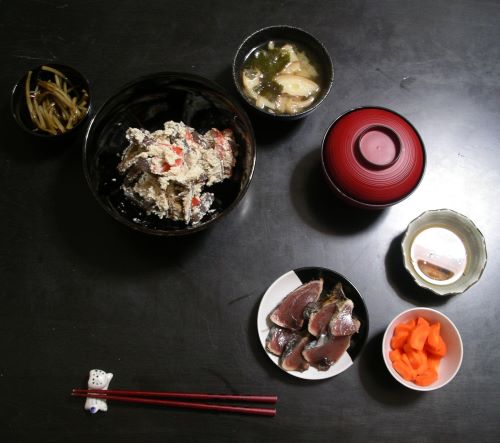 Making the dinner was pretty time-consuming, as was the cleanup. It was totally worth the effort.
Fugu, the pufferfish perhaps best known for its potential lethality as a foodstuff, is in season now. This restaurant is advertising its Fugu Festival. 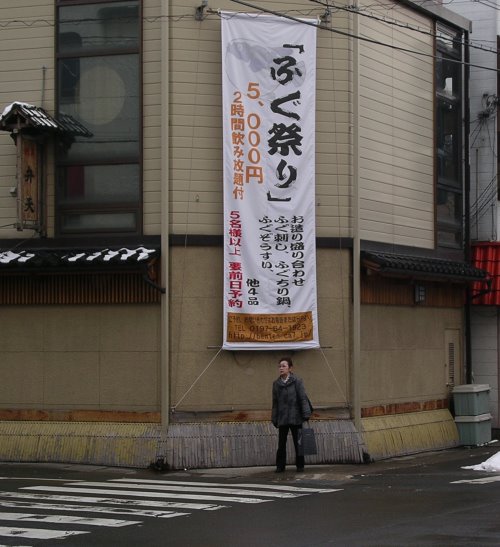 The festival appears to be featuring a sampler of fugu dishes, including fugu sashimi, fugu chirinabe (hotpot), and fugu zousui (rice porridge mixed with soup). There are four other unnamed dishes available as well. It's 5,000 yen for two hours of nomihoudai (all-you-can-drink) and the fugu sampler ― we're passing on this one.
[ 3 comments ] permalink
December is the busiest month of the year in Japan. Nengajou need addressing, bonenkai (year-end parties, of which there tend to be many) need attending, and houses receive thorough cleanings. By the time New Year's Day rolls around, people are tired and want some relaxation. Traditionally, families would visit their local shrine to offer prayers for the new year before retiring at home for a day of drinking sake, reading nengajou, and eating osechi ryouri. Osechi ryouri are the traditional New Year's foods. Each food is eaten for a purpose: health, longevity, or wealth, among others. Historically, they are prepared in advance and stored in a large, three-tiered box ( juubako) until New Year's Day; consequently, they tend to be heavily salted, sweetened, or vinegared for preservation purposes. Although people still make osechi at home, you can also buy most of the traditional foods already prepared. We had a small subset of osechi, including some non-traditional treats that had been given to us as gifts earlier in the weekend. 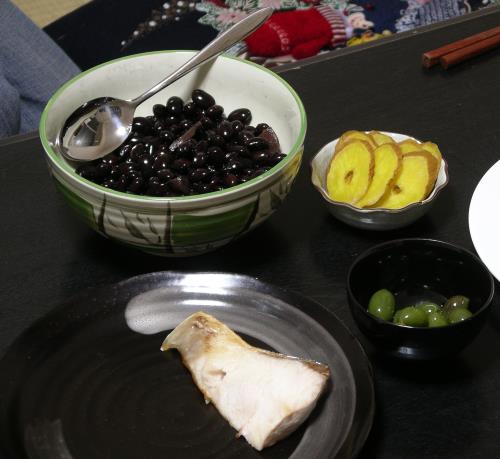 Clockwise from the top left: kuromame (sweetened black beans, eaten for health); iburigakko (smoked pickled daikon radish, an Akita specialty that a friend gave us); Japanese olives (a gift from the same friend); and salt-grilled yellowtail. 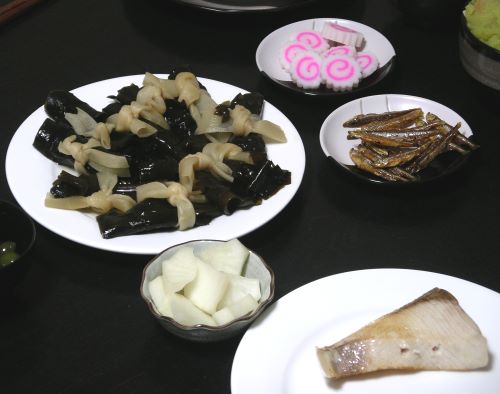 Clockwise from the left: konbumaki (simmered kelp rolls tied with gourd strips, eaten for happiness); kamaboko (fish paste; red and white are auspicious colors for the new year and symbolize celebration); tazukuri (candied sardines, symbolizing an abundant harvest); and rice bran pickled daikon. 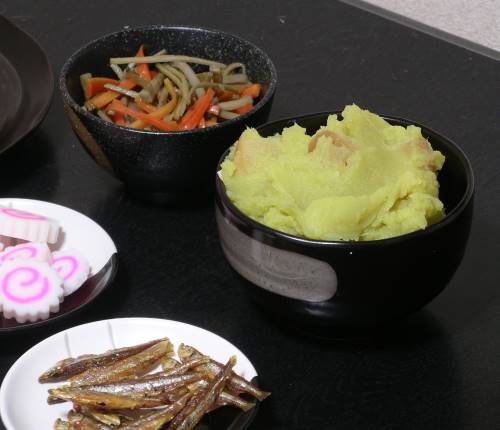 Clockwise from left: another look at the kamaboko; kinpira gobou (simmered burdock root and carrot); ringo kinton (mashed sweet potatoes and apples; eaten to bring good luck); another look at the tazukuri. Not technically part of the osechi, ozouni is also traditionally eaten on New Year's Day. 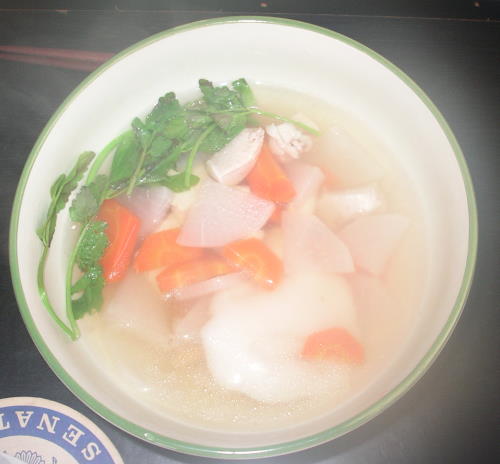 According to our local friends, ozouni in Iwate consists of a clear soup base, chicken, daikon, carrot, ikura (salmon roe), Japanese parsley, and mochi. We had ours for lunch, before a lovely drive to Semi Onsen, where we enjoyed a New Year's soak in the rotenburo, surrounded by two feet of snow.
Our first Christmas in Japan is over, save for the sort of "second Christmas" we get by virtue of having family in the U.S. We can call people pretty much any time between the morning of the 25th and the morning of the 26th, and it's Christmas for someone. It's really rather nice. Christmas isn't really a big deal in Japan. It's not a national holiday, so we got mail delivery today, and most people worked. Also, turkey is essentially nonexistent here, so many families celebrate with KFC. We couldn't make ourselves get KFC, opting for an all-American dinner of steak, mashed potatoes, and grilled asparagus. Matthew hasn't had mashed potatoes in at least nine months, so he was pretty excited about them. We did, however, follow tradition and get a Christmas cake. 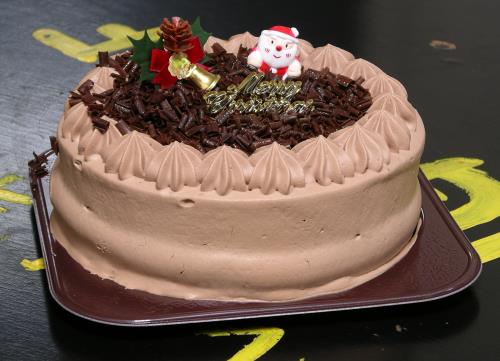 As we've mentioned before, the Japanese Christmas cake is traditionally sponge cake with whipped cream and strawberries. We ordered one with chocolate whipped cream, which turned out to have bits of pineapple and peaches in the middle. It came with a box of strawberries for garnish. 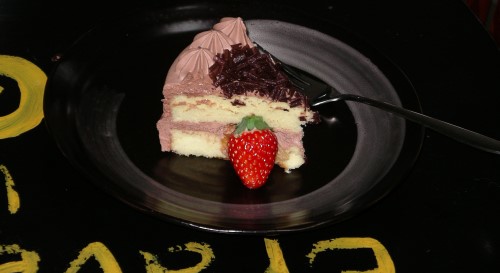 It was pretty tasty, too. Merry Christmas, everyone!
On Toji, the winter solstice, the Japanese greet the end of darkening days with traditions aimed at improving health. Grocery stores are filled with yuzu, a small yellow citrus fruit with a taste and aroma similar to grapefruit. It is traditional to toss a few yuzu into the ofuro, allowing you to relax in a hot bath surrounded by the fragrant oils. Similarly, eating kabocha (Japanese pumpkin) on the solstice is believed to prevent colds in the coming year. We celebrated Toji by mixing traditions ― and cocktails. An acquaintance had gifted us with a kabocha some time ago, so we simmered it for dinner with some fresh ginger (given our track record, we're all about combining as many cold-prevention ingredients and traditions as possible). We filled our ofuro with sliced yuzu for a refreshing end to a difficult week. And, we shook yuzu juice with gin and Cointreau in a celebratory cocktail, raising our glasses to the return of light and the prospect of good health in the coming year.
We've both been here long enough to have unusual experiences and eat unusual things. On the eating front, they've almost always been things we've chosen to eat ― nobody really springs freaky stuff on the unsuspecting gaijin. For example, one night at Hige-oyaji's place, he started showing us some more adventurous Japanese foods, including hizunamasu, a Hokkaido regional specialty. Hizunamasu is thin slices of pickled salmon head, cartilage and all. I rather liked it; it makes a nice accompaniment to a mug of beer. He also showed us his big jar of shiokara, which Wikipedia defines as "small pieces of the [sea] animal's meat in a brown viscous paste of the animal's heavily salted, fermented viscera." It's frequently served with shots of sake, perhaps to no one's surprise after that description. We'd gone there a number of times before that night, so we assumed that he'd only busted out the potentially yak-inducing fish preparations because he knew us well enough to know that we wouldn't gag or otherwise freak out. So it was with little or no trepidation that we visited a new-to-us fish restaurant earlier this week. The owner/chef had a pretty standard set of dishes on his menu: nabe teishoku (hotpot served with rice, pickles, and another side of some type); grilled fish teishoku (same thing, but with grilled fish in place of the hotpot and with miso soup); fried fish, maybe an oyster stew. Matthew ordered the seafood nabe teishoku, I went with grilled fish. Things were proceeding as they usually do until we were served. Then the following conversation took place: MAD: I don't know how to eat a whole fish head. SKD: Oh, farm. Is that shiokara? Indeed, on our trays sat little bowls of shiokara, apparently a standard teishoku dish at this restaurant. We ate our other things, glancing at the ruddy brown dish every now and again. Finally, we each bit the bullet and tried it without the benefit of sake because we still had work to do. And. . . it wasn't half bad ― it was quite salty, and tasted rather like fishy miso with bits of squid in it. Mostly, it was a good reminder of what should be the motto for our lives here: expect the unexpected.
At dinner the other night, a local friend brought a small piece of wasabi and a grater along. The grater surface is sharkskin. 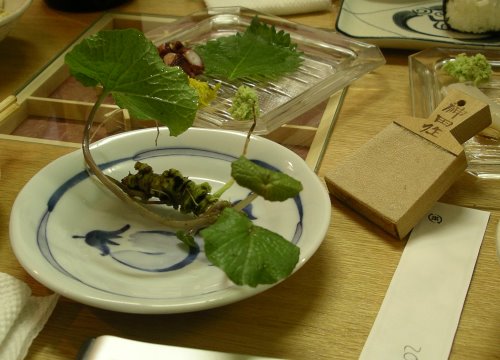 He showed us how to grate the wasabi by gently rubbing the root in circles on the grater, then let the rest of us try. We ate it on sashimi of octopus, squid, and salmon. Oishikatta desu!
Sponge cakes with strawberries, whipped cream, and placards
Cheesecakes with gold dust for holiday snackers
Chocolate yule logs with Santas and sleighs
These are a few of the cakey displays . . . Here in Japan, no Christmas is complete without a Christmas cake. Christmas cake is traditionally sponge cake with whipped cream and strawberries. It has morphed into far more extravagant things, like cheesecakes or chocolate cakes covered in ganache (melted chocolate mixed with cream, and sometimes liqueur). You can also get them decorated with white chocolate Mickey-head plaques or holiday wishes from Kitty-chan. Grocery stores, conbini, and patisseries have had these glossy brochures out for about three weeks now, advertising their scrumptious holiday wares. 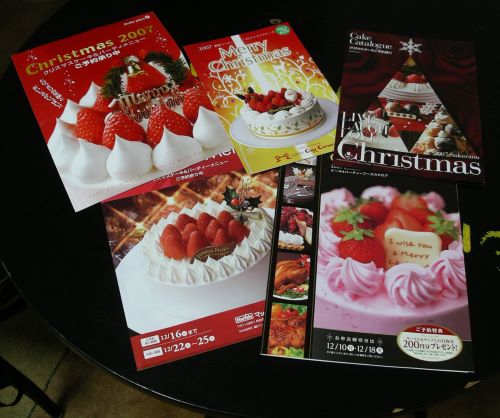
[ add comment ] permalink
Back Next
|
|









 Calendar
Calendar




